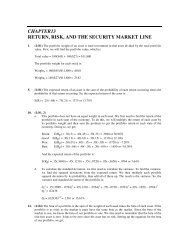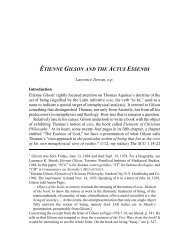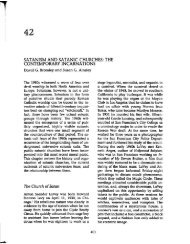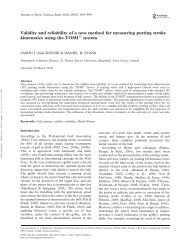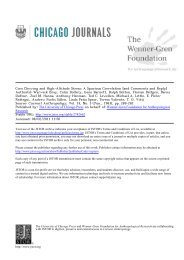Health and the Social Construction of Masculinity in Men's Health ...
Health and the Social Construction of Masculinity in Men's Health ...
Health and the Social Construction of Masculinity in Men's Health ...
Create successful ePaper yourself
Turn your PDF publications into a flip-book with our unique Google optimized e-Paper software.
Stibbe / MASCULINITY IN MEN’S HEALTH MAGAZINE 49<br />
That is not to say that Men’s <strong>Health</strong> does not conta<strong>in</strong> useful health <strong>in</strong>formation.<br />
It does. An article <strong>in</strong> <strong>the</strong> July/August (2000, 34) issue, for example,<br />
describes what to do when calf muscles cramp up. This is useful advice with a<br />
health goal <strong>and</strong> no particular political agenda. However, <strong>in</strong> a significant number<br />
<strong>of</strong> cases, <strong>the</strong> presentation <strong>of</strong> health goals simultaneously re<strong>in</strong>forces hegemonic<br />
mascul<strong>in</strong>ity <strong>and</strong> <strong>the</strong> unhealthy behavior associated with it. Lifestyle<br />
articles not specifically about health fur<strong>the</strong>r contribute to this by directly<br />
encourag<strong>in</strong>g unhealthy behavior. An example is <strong>the</strong> article about what to<br />
br<strong>in</strong>g to <strong>the</strong> football game: “Br<strong>in</strong>g 2 ½ beers per hour per person. . . . Plan on<br />
two or three hot dogs, burgers or sausages per person” (October 2000, 54).<br />
The magaz<strong>in</strong>e tells readers what <strong>the</strong>y want to hear at a time when hegemonic<br />
mascul<strong>in</strong>ity is be<strong>in</strong>g challenged by messages that red meat is harmful,<br />
excess alcohol is dangerous, convenience food is unhealthy, sexism is unacceptable,<br />
<strong>and</strong> animals have rights. And <strong>the</strong> reassur<strong>in</strong>g advice, ostensibly<br />
backed up by <strong>the</strong> authority <strong>of</strong> science, comes from <strong>the</strong> mouth <strong>of</strong> a trusted<br />
buddy.<br />
Testosterone, <strong>the</strong> ultimate symbol <strong>of</strong> mascul<strong>in</strong>ity, is sold hard: “Better<br />
muscles! Better sex! Thicker hair! Get ’em all,” <strong>the</strong> contents page (December<br />
2000) urges. But <strong>the</strong> extra hair will appear only on <strong>the</strong> face <strong>and</strong> body, two<br />
places <strong>the</strong> cover models shave. Boost<strong>in</strong>g testosterone may have health benefits,<br />
but it is here that <strong>the</strong> real agenda <strong>of</strong> <strong>the</strong> magaz<strong>in</strong>e can be seen: “The more<br />
testosterone you have, <strong>the</strong> more dom<strong>in</strong>ant you’re likely to be, <strong>and</strong> <strong>the</strong> less<br />
crap you’ll take from pencil-necks who don’t pack as much <strong>of</strong> <strong>the</strong> hormone<br />
under <strong>the</strong>ir shorts” (December 2000, 100). The accompany<strong>in</strong>g pictures,<br />
“from this” (a picture <strong>of</strong> a wimp) “to this” (a gladiator <strong>in</strong> <strong>the</strong> heat <strong>of</strong> battle)<br />
(December 2000, 100), appear at a time when “<strong>the</strong>re is constant evidence that<br />
American men express significantly more aggression than American<br />
women” (Courtney 2000a, 103). Encourag<strong>in</strong>g men to <strong>in</strong>crease <strong>the</strong>ir aggression<br />
might help <strong>the</strong>m “dem<strong>and</strong> ano<strong>the</strong>r 10 gr<strong>and</strong> from your boss or else”<br />
(December 2000, 100), but this serves <strong>the</strong> goal <strong>of</strong> <strong>in</strong>creas<strong>in</strong>g male power<br />
ra<strong>the</strong>r than improv<strong>in</strong>g men’s health. Like <strong>the</strong> o<strong>the</strong>r behaviors described <strong>in</strong><br />
this article, men’s aggression “contributes to <strong>the</strong>ir health risks <strong>and</strong> premature<br />
deaths” (Courtney 2000a, 103).<br />
Men, it seems, are do<strong>in</strong>g someth<strong>in</strong>g wrong. And <strong>the</strong> discourse <strong>of</strong> traditional<br />
mascul<strong>in</strong>ity is encourag<strong>in</strong>g <strong>the</strong>m to do so <strong>in</strong> <strong>the</strong> name <strong>of</strong> male power<br />
<strong>and</strong> privilege over women. Courtenay <strong>and</strong> Keel<strong>in</strong>g (2000) write that “<strong>the</strong><br />
presence <strong>of</strong> men’s health (<strong>and</strong> <strong>of</strong> a magaz<strong>in</strong>e bear<strong>in</strong>g that name) on newsst<strong>and</strong>s<br />
<strong>and</strong> television shows suggests <strong>the</strong> gradual development <strong>of</strong> a shared,<br />
public concept <strong>of</strong> men’s health” (p. 243). However, to truly address men’s<br />
health needs, all participants <strong>in</strong> <strong>the</strong> creation <strong>of</strong> this concept will need to challenge<br />
<strong>the</strong> discourse <strong>of</strong> hegemonic mascul<strong>in</strong>ity <strong>and</strong> work toward <strong>the</strong> social<br />
construction <strong>of</strong> a new, healthier form <strong>of</strong> mascul<strong>in</strong>ity.



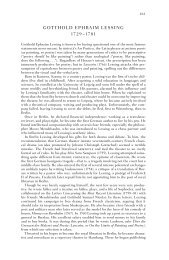

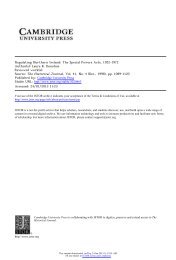

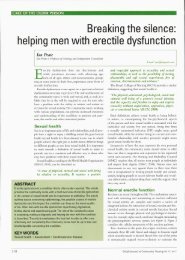
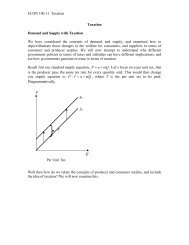
![The Rink - Cyril Dabydeen[1].pdf](https://img.yumpu.com/21946808/1/155x260/the-rink-cyril-dabydeen1pdf.jpg?quality=85)

